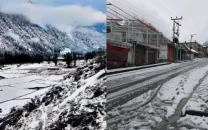Global warming : Climate change a threat for Chitral’s women
Flooding due to melting glaciers puts residents in danger and out of reach of sufficient healthcare

While the threat of climate change is severe for the entire world, it grows tenfold for the pregnant women in Chitral Valley during the summer when the area experiences never- seen-before rises in mercury.
The residents of Upper Chitral and Lower Chitral, who live in slums nears glaciers and pregnant women in particularly are at a constant risk due to glacial lake outburst flood (GLOF), which is the sudden release of water from a lake fed by glacier melt that has formed at the side, in front, within, beneath, or on the surface of a glacier.
Dozens of women have been trained in first aid in Chitral to minimize the potential loss of life due to the dangers of GLOF in the summer. Merajuddin, who is the General Manager of the Aga Khan Foundation Health and Care in Pakistan, told the Express Tribune that there are about 2,000 births a year in these areas. “In areas where government agencies do not have access, 34 health facilities are being provided. Our Lady Health Workers (LHW) for Pregnant Women are already present in these areas in December, January and February when there is continuous heavy snowfall and roads are closed in glacier areas,” he informed.
Due to their work in such extreme conditions these LHW have earned the title of ‘Snow Ladies’ as per Merajuddin. He further added that these Snow Ladies, along with the foundation’s mobile units, also operate in high-risk natural disaster areas, where there are between 300 and 400 deliveries to manage even during months which pose extreme dangers. “In such uncertain weather conditions, the Snow Ladies try to minimize the difficulties of pregnant women who are experiencing seasonal hardships,” he said.
One of the significant reasons for a GLOF is snow melt due to the rise in temperature. Noor Kamal, Assistant Director of the Meteorological Department in Booni, Chitral, told the Express Tribune that with the rise in global temperatures, temperatures in the snowy valleys and mountains of Khyber Pakhtunkhwa (K-P) have also started rising. “The snowfall in Chitral city has dropped from two to three feet in the past to just mere inches now, while in June and July the temperature has started rising to 40 to 42 degrees celsius,” she informed. In the near future, the rising temperatures are expected to affect a population of 15,000 to 20,000 in the Upper Chitral areas of Ration Village, Madak Lasht, and Arkari Valley.
“We have so far identified 380 villages in Chitral that have been affected by natural disasters and that have been included in the red zone.,” said Amir Mohammad, who has been in Chitral for many years, dealing with natural disasters, “of these, 90 villages are in Upper Chitral, 33 of which 33 are high risk areas for falling glaciers.”
To avoid tragedies, the GLOF-1 project was introduced under which the Automatic Weather Station (AWS) equipment was installed in these areas. Sources indicate that GLOF-1 had good results in mitigating the risks, so now in the upcoming season the GLOF-2 project will be introduced in high risk areas. Mohammad Fahad, Provincial Coordinator of the GLOF-2 project in K-P, said that early warning systems are being installed in areas where melting glaciers and GLOF pose high risks.
“In addition, 30 slides along with 30 flood protection walls will be installed by next year and slope staplers will also be installed to prevent sliding. Work is also under way in Upper and Lower Chitral to rehabilitate the irrigation channels which were destroyed by sliding in the past three years,” Fahad informed The Express Tribune.
Published in The Express Tribune, January 31st, 2022.



















COMMENTS
Comments are moderated and generally will be posted if they are on-topic and not abusive.
For more information, please see our Comments FAQ